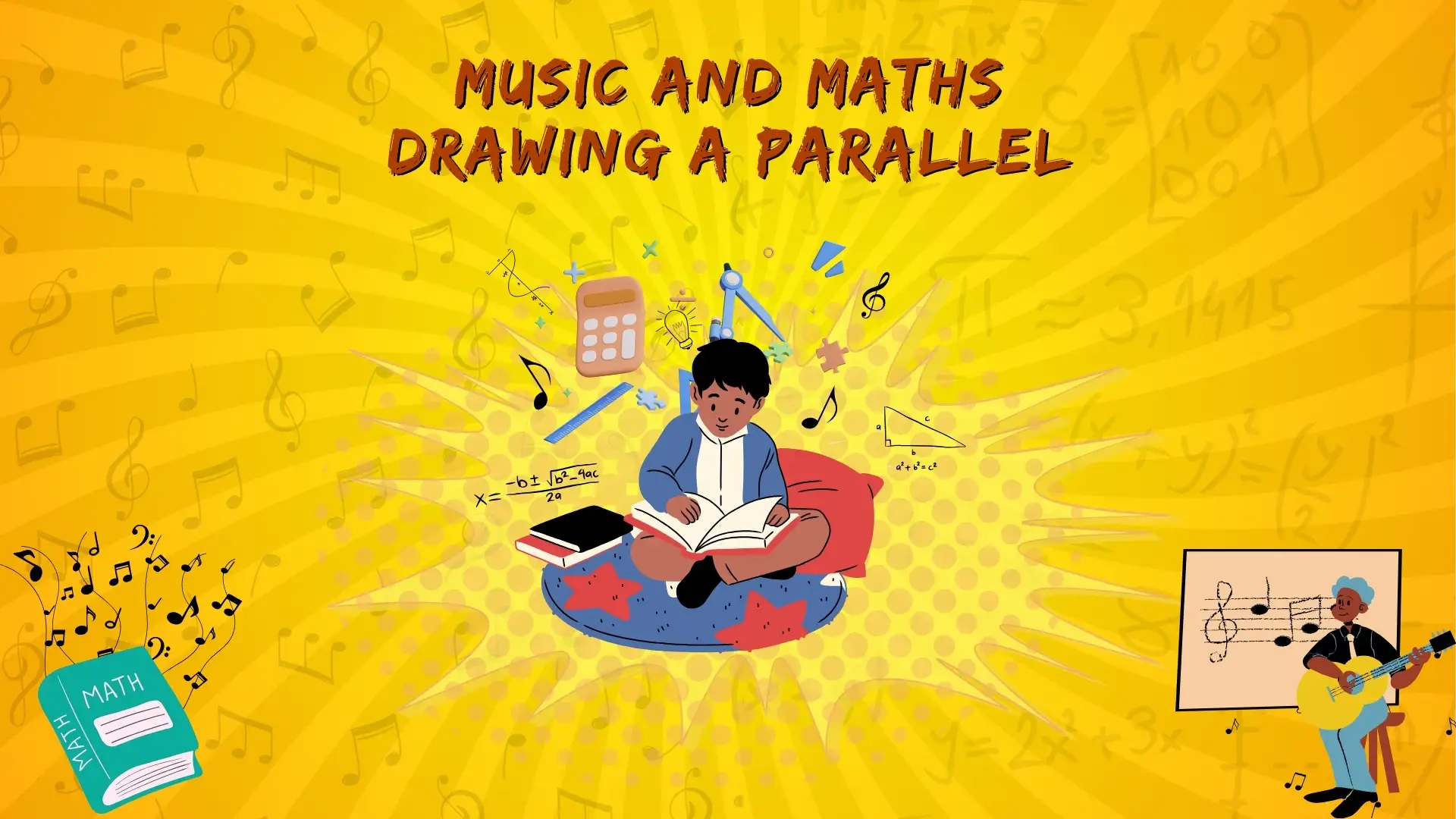Math and music connection seem two very unrelated disciplines. One deals with numbers and equations while another deals with sound and emotions. But when we look closely, we can find out that these two disciplines are deeply connected. Math is utilized significantly with music theory for organized music compositions.
The concept of music theory is described as the grammar of music because it allows an individual to understand how different components of music relate and form pleasant sounds.
Through an understanding of elements such as scales, chords, intervals, and rhythm, and their interactions, musicians can create music in a more informed way. They can play it with better precision, and be able to discuss it with greater intelligence. But, what does this music theory have to do with math? How is math utilized in music? Let’s understand the relationship between music theory and mathematics through history.

The harmony of the cosmos sees music and mathematics waltzing hand in hand with beats transforming into formulas and tunes arising from patterns, in numbers.
Pythagoras and the strings: A Historical music and math connection
The music and math connection goes back centuries. One of the most famous stories in this regard involves Pythagoras, a brilliant mathematician from ancient Greece. According to legend, Pythagoras experimented with hammering strings on a monochord (an instrument with a single string). He discovered that shortening the string by half produced a note an octave higher. This observation led him to explore the mathematical relationship between string lengths and the resulting musical intervals. Pythagoras’ experiments helped lay the foundation for understanding musical consonance and dissonance based on mathematical ratios.
Mathematical concepts in music
1. Mathematical ratios and scale construction
Different scales like major, minor, etc. are built using specific mathematical ratios between the frequencies of the notes.
For example, a major scale is constructed based on a series of whole and half-step intervals. Each interval has a specific frequency ratio. The perfect fifth interval, a fundamental building block of major scales, has a 3:2 frequency ratio. By stacking these ratios together, musicians can create the characteristic sound of a major scale.
2. Mathematical formulas and chord building
Chords are built using specific intervals between their notes. These intervals can be expressed mathematically using frequency ratios.
For instance, a basic major triad (the most common type of chord) is built with a major third (4:5 ratio) and a perfect fifth (3:2 ratio) on top of the root note. Understanding these ratios allows musicians to build complex and beautiful harmonies.
3. Temperament and tuning systems
The tuning of musical instruments is deeply rooted in mathematical principles. For instance, the equal temperament tuning system divides an octave into 12 equal intervals, each corresponding to a semitone. This division involves logarithmic calculations, demonstrating a mathematical basis for tuning. The following video is about the basic physics of sound, mathematically proving that a few instruments can’t be in perfect tune and also proposes a few solutions to make it right.
4. Rhythm and time signatures
Rhythm refers to the organization of musical time through beats and accents. Time signatures, like 4/4 or 3/4, use fractions to represent the number of beats per measure and the type of note that gets one beat.
In a 4/4- time signature, the first number 4 tells us that there are four beats in every measure, and the second number (also 4) indicates that a quarter note takes up one beat. This approach helps musicians keep accurate records of complicated rhythms and subsequently play them.
5. Mathematical structure in compositions
Composers use mathematical structure in compositions. For instance, fibonacci sequences have been identified in the works of certain composers like Claude DeBussy and Beethoven, as an intentional application of mathematical patterns in music.
6. Formal structures
The formal structures of sonata-allegro, ternary, or rondo defines the musical forms. These structures make use of repetition, variation, and proportions to achieve an integrated and satisfying musical experience.
7. Meter and counting
In the case of beat and measure counting, which is the basis of music, there are some calculations as a way for musicians to work on the basic arithmetic level. When it comes to playing intricate rhythms and interpreting musical notation with unconventional time signatures, artists utilize math for musicians and ideas to make their process smooth.
Before moving on to Mathematical precision in Music in the digital age, lets see the music representation in math.

Did You Know?
The relationship, between music and mathematics runs deep. Mathematical concepts are used to dissect components such as rhythm, harmony and melody. For instance musical notes adhere to ratios and rhythms can be represented through fractions or patterns.
Mathematical precision in music in the digital age.
In modern music production, math plays a significant role in several important areas such as:
Digital audio workstations (DAWs)
A DAW, or digital audio workstation, is a type of software that musicians use to create music by recording, editing, and manipulating sounds. Here comes the interesting part. The quality of sound created using a DAW depends on the math. Accurate mathematical calculations will give high quality sounds.
Sample rates and bit depth
These two define the quality of the audio. The number of times a second the sound wave is captured in digital form is called sample rates. Bit depths refer to the precision of each measurement from the sound source. They all rely on numerical values and calculations to record high-quality sound recordings at an audiophile level.
Digital signal processing (DSP)
In the world of digital signal processing, DAWs rely on DSP approaches to use audio in different ways. All of these techniques, such as equalization, compression, and reverb, work with complex mathematical algorithms that help create specific sonic results.
MIDI (Musical instrument digital interface)
MIDI (Musical instrument digital interface) is a protocol for communication that permits the musician to manipulate musical instruments, and digital and electronic software synths by delivering digitally-driven data rather than voice or analog signals. The data usually represents musical note information such as pitch, duration, and velocity in numeric form so that it undergo more easy manipulation by computers for playback or other applications.
Music notation software
Programs like Sibelius or Finale are music notation softwares, which allows musicians to compose and modify digital scores. The programs are based on mathematical equations to precisely depict the musical features of the staff.
In music, the note’s position on the staff indicates a particular numerical measurement established by pitch. The length of a beam, as well as the bar lines and other graphic entities, all result from calculations made according to rhythmic values (fractions) and time signatures. This results in a visual representation of musical ideas, and it is very accurate and clear.
Before concluding, this is how addition works in Music
Conclusion
In conclusion, no matter how different these two disciplines seem, their interconnection is undeniable. Music and Math connection will be always an area of researchThe melodies that move us and the rhythms that make us groove are nothing but a beautiful synergy between music and math. Further, from the seemingly simple use of fractions in notation to the complexities of ratios and scales, mathematical principles form the hidden order behind the music we love.
Therefore, recognizing and understanding the connection between these two different streams will surely help music enthusiasts enhance their skills. Whether you are a novice or advanced learner, elevate your musical skills under our expert guidance only with us at MUSIC MASTER!
Unlock the secrets of Sound, explore unseen details about Music with us! This blog will give insights that will change the way you have been listening to music so far, yes you are right! You will appreciate music, knowing the amazing facts of historical anecdotes to scientific discoveries, this article is a must read for all the music enthusiasts out there!
FAQs
What are the benefits of music education for children?
The benefits of music education for children are it improves cognitive development and enhances academic performance.
How to learn a musical instrument?
One can easily learn a musical instrument by practicing more, being dedicated, patience and expert guidance from a qualified guru/instructor.
What are the different music genres?
The different music genres include classical, rock, jazz, pop, hip-hop, and electronic.
What is the music and math connection?
Music and math are inter-related with concepts like rhythm, harmony and patterns.
What are the similarities between music theory and mathematical principles?
The similarities between music theory and mathematical principles are their structure, logic, and abstraction.
How does learning music enhance mathematical skills?
Surprisingly, learning music enhances mathematical skills by improving logical thinking and problem-solving abilities.
Are there any famous musicians who were also skilled mathematicians?
Skilled mathematicians who applied mathematical principles in their music are Pythagoras, Johann Sebastian Bach, and John Coltrane and the count goes on.
Related Post: Unheard Facts about music































